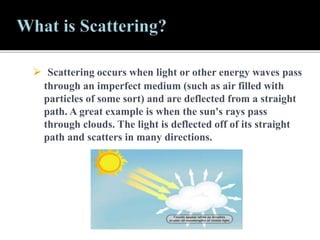This document discusses different types of scattering phenomena including Rayleigh scattering, Raman scattering, stimulated Raman scattering, and hyper Raman scattering. Raman scattering occurs when light interacts with molecules or atoms, causing the emission of photons with different wavelengths than the incoming light. Stimulated Raman scattering is amplified when the intensity of the excitation beam is high enough to greatly enhance the strongest Raman signal. Hyper Raman scattering is a weaker effect where two pump photons generate one scattered photon and one phonon.











